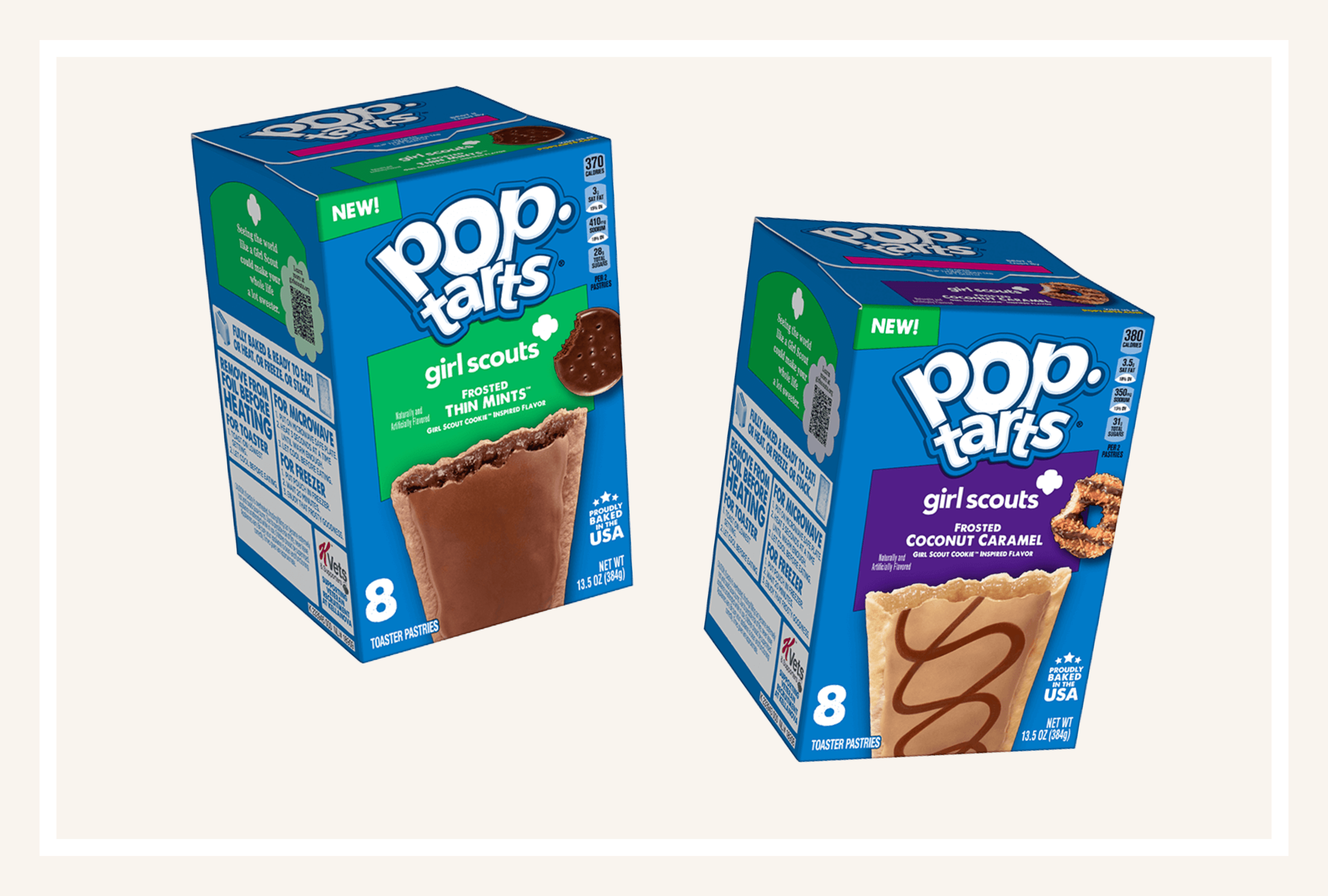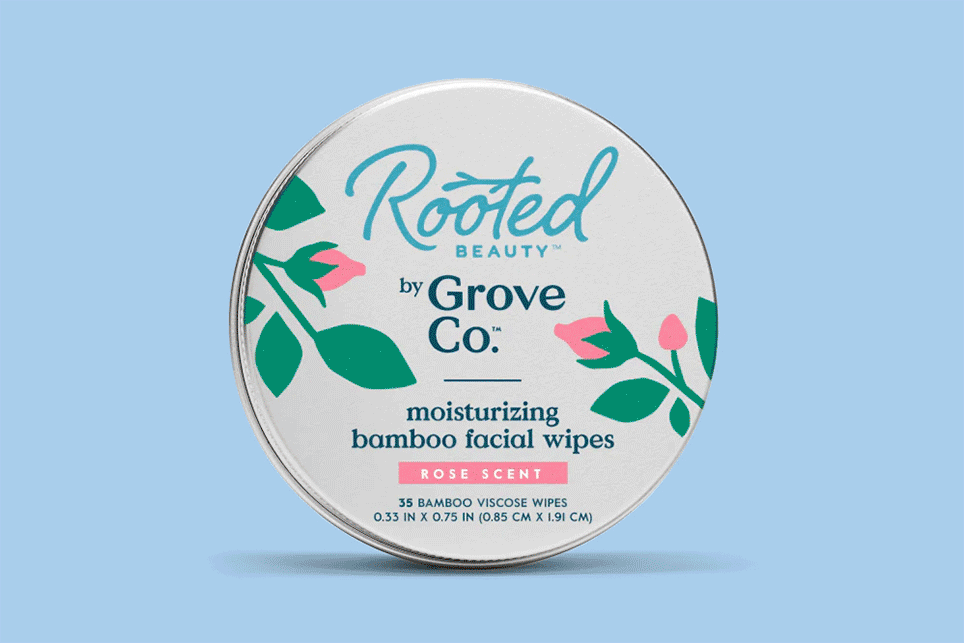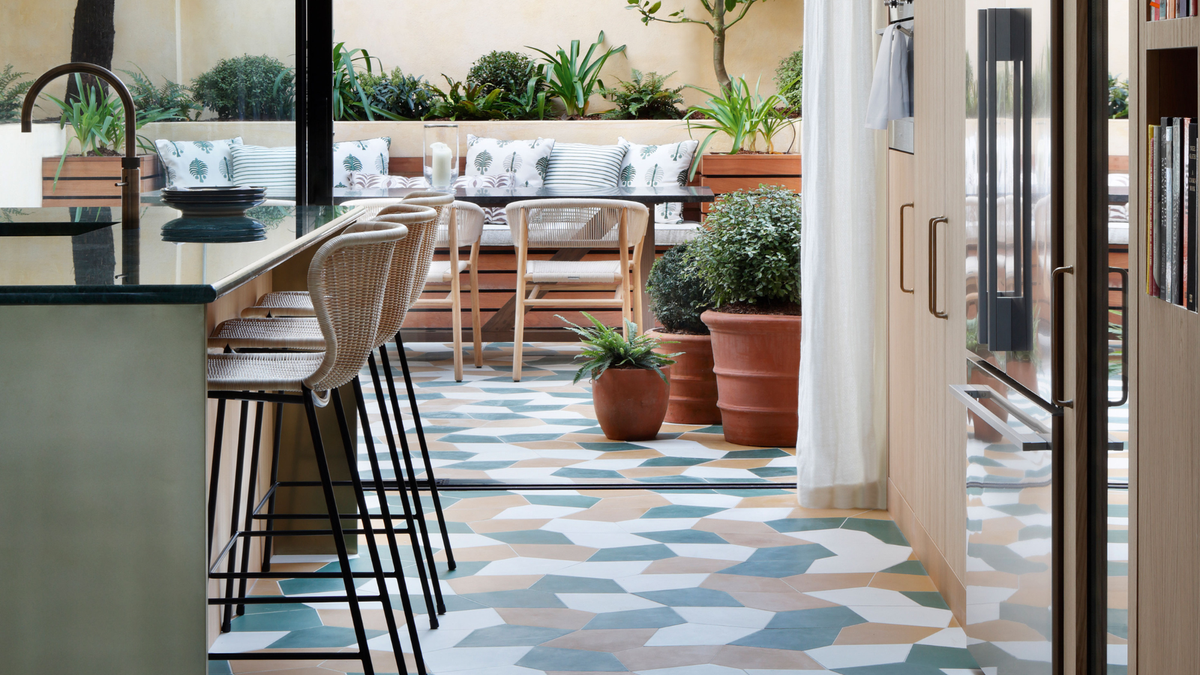
11 Kitchen Flooring Ideas to Build a Brilliant Renovation Scheme From the Ground Up
Unlike some features of your kitchen, once the flooring is in place, it can be pretty difficult to change, so it’s one of those choices that has a lot of weight in the finished design, and the future of, your kitchen renovation.
For some people, that means it tracks to keep kitchen flooring ideas simple — however, in some of the most exciting modern kitchens we’re seeing, interior designers are taking a big swing with pattern, colour and material to make these spaces feel bolder and more in-tune with the personality of those using the space.
To get you thinking about what’s the right path for your own kitchen flooring, with collected some of the most relevant ideas for today, along with expert advice from interior designers and product experts on how to make a decision you won’t regret.
1. Match With Your Worktop Materials
Reducing the materiality of your kitchen scheme boosts its minimalist qualities.
(Image credit: Christian Brailey. Design: Architecture for London)
According to the experts, flooring is a good place to begin when choosing kitchen materials. “We usually start with the floor and ideally matching kitchen countertops, as these have a tight set of performance and aesthetic parameters, depending on the project and client preferences,” says Ben Ridley, founder of Architecture for London. “Joinery and cupboard front materials generally have many more potential options, and can therefore be selected later to complement other elements, once the flooring and worktops are agreed upon.”
2. Prioritize Strength and Beauty

Slate is an enduring choice for a kitchen floor.
(Image credit: Darren Cheung. Design: Sola Kitchens)
“Above all, kitchen floors need to be hardwearing,” advises London-based interior designer Alex Dauley. “A high-traffic area used for cooking requires a floor that is resistant to stains and moisture.”
“I love to use engineered wood, porcelain tiles or a natural material like limestone or slate kitchen flooring,” the designer adds. “They each have the ability to create striking and beautiful looks, without compromising on functionality, although natural stone does need more maintenance.”
Sarah Peake of Studio Peake agrees that durability is paramount. “Flooring is something that can’t be changed easily once the house is finished, so finding an option that is practical as well as beautiful is key. I also make sure that the floors I specify are suitable for use with underfloor heating, because there’s nothing worse than cold toes in the kitchen,” Sarah adds.
3. Use Practical Pattern Over Plains
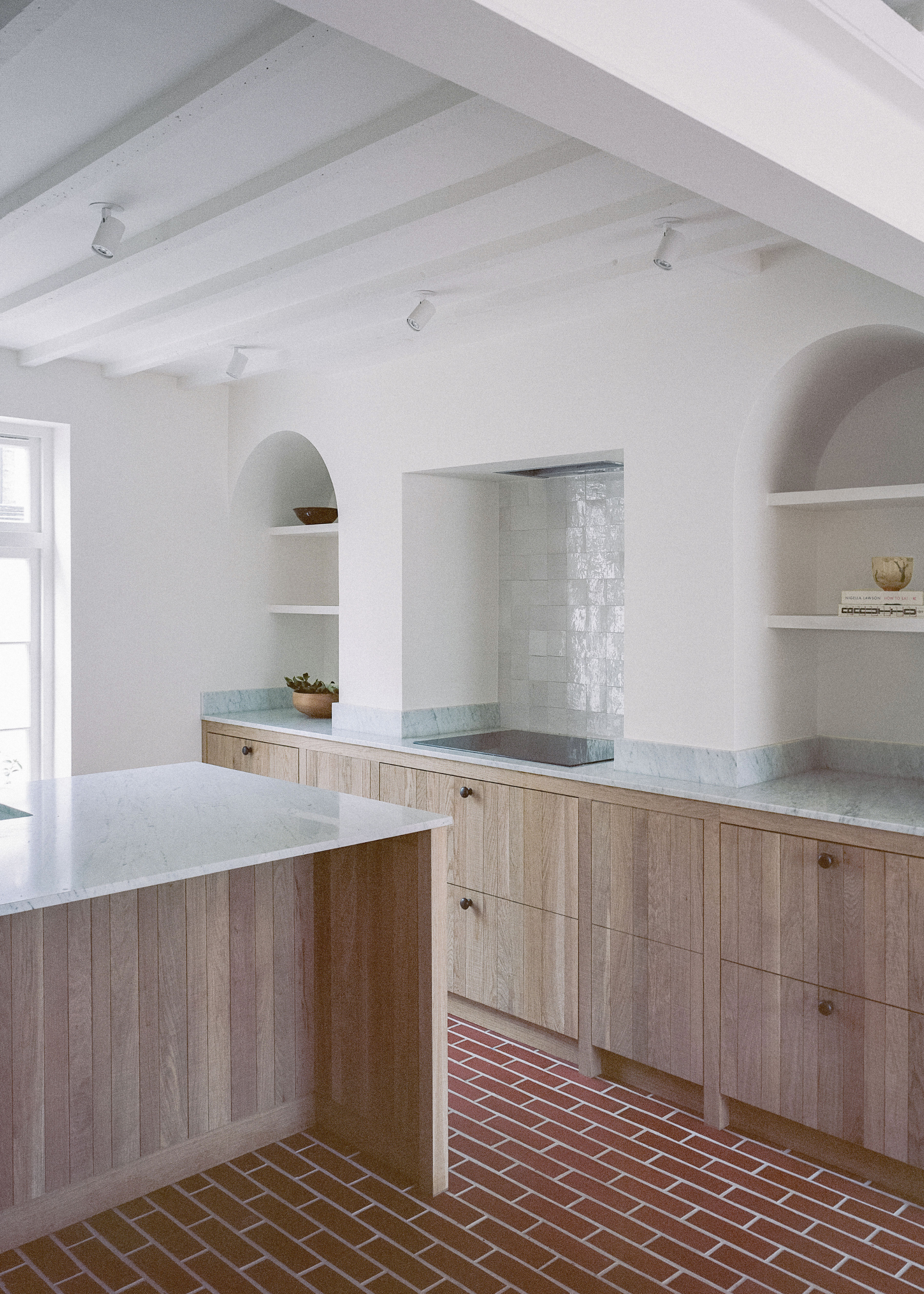
Architecture for London transformed the kitchen of this listed Georgian home with a richly-colored, brick-tiled floor.
(Image credit: Building Narratives. Design: Ben Ridley/Architecture for London)
“It’s always worth considering a stone floor with a busy texture rather than something plain, as a pattern will conceal the inevitable marks and dirt much better,” advises Ben Ridley. For the same reason, steering clear of very pale shades can also be a wise move, particularly if your space can accommodate a darker floor.
Architecture for London selected a brick flooring inspired by Jim Ede’s Kettle’s Yard for a lower-ground kitchen in a Grade II-listed Georgian home, where light grout lines and a palette of pale materials keep the space feeling bright and airy. It’s not pattern, as such, but it’s a busier finish than a large-scale tile.
If lack of light is a concern, Ben recommends a honed stone tile with a semi-polished finish.
4. Choose Engineered Wood for Kitchens
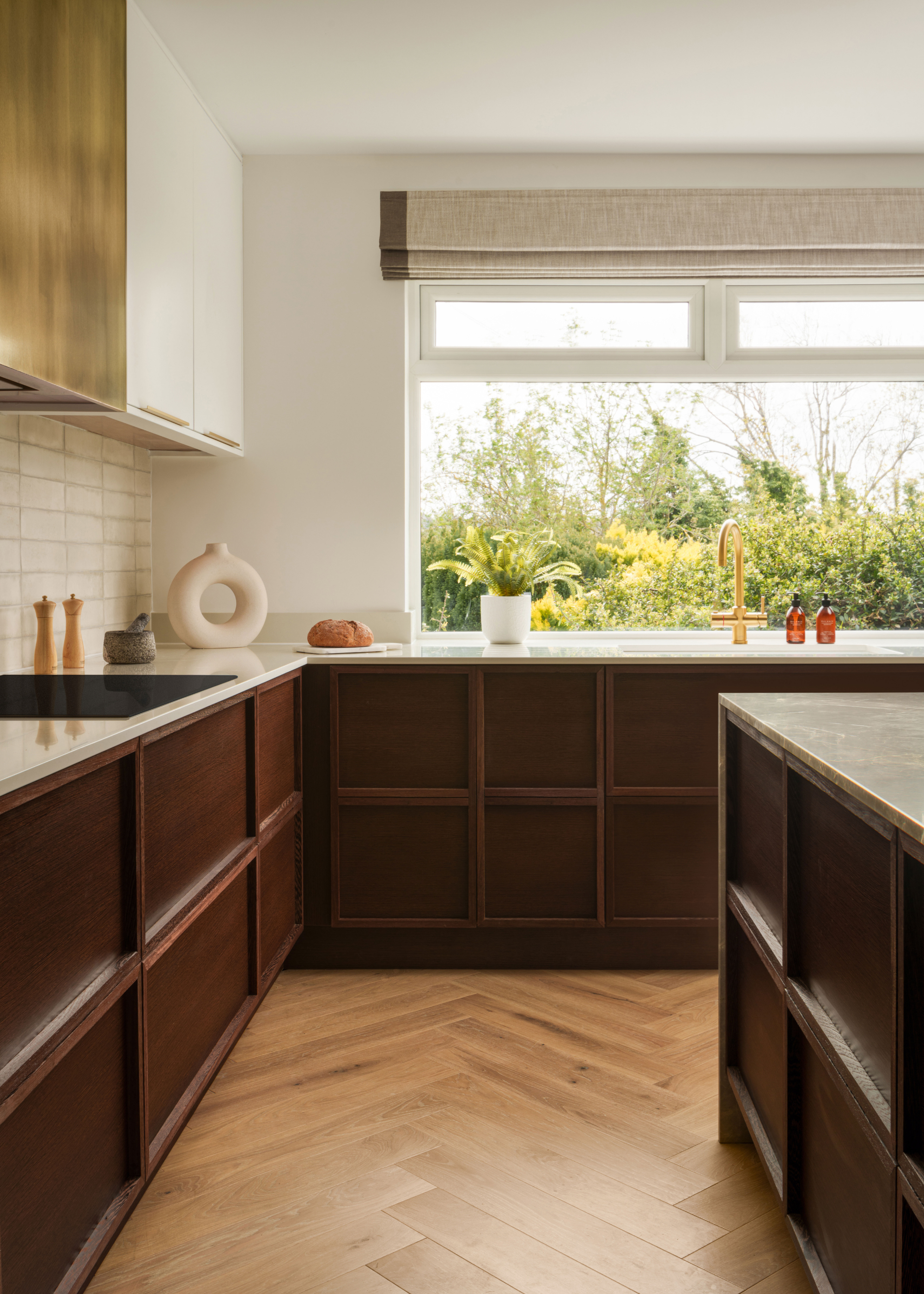
Alex Dauley chose an engineered oak floor to complement a palette of natural materials in this South London home
(Image credit: Vigo Jansons)
Engineered wood is a good option if you like wood kitchen flooring ideas as it is much more resistant to heat and moisture than solid-wood boards. Alex Dauley chose engineered wood flooring for a recent South London remodel.
“It was a whole-house renovation project designed for a client who wanted a sense of calm and relaxation in their home,” she says. “The aesthetic is modern with neutral tones and warm, natural materials. The engineered oak floors, laid in a herringbone pattern, were chosen to run throughout the ground floor to create a cohesive and timeless look.”

Alex Dauley
London-based interior designer Alex Dauley is often featured in the pages of Livingetc. In 2025, her studio is designing a room for Chelsea Harbor Design Centre’s Wow!House.
5. Be Brave in Small Kitchens
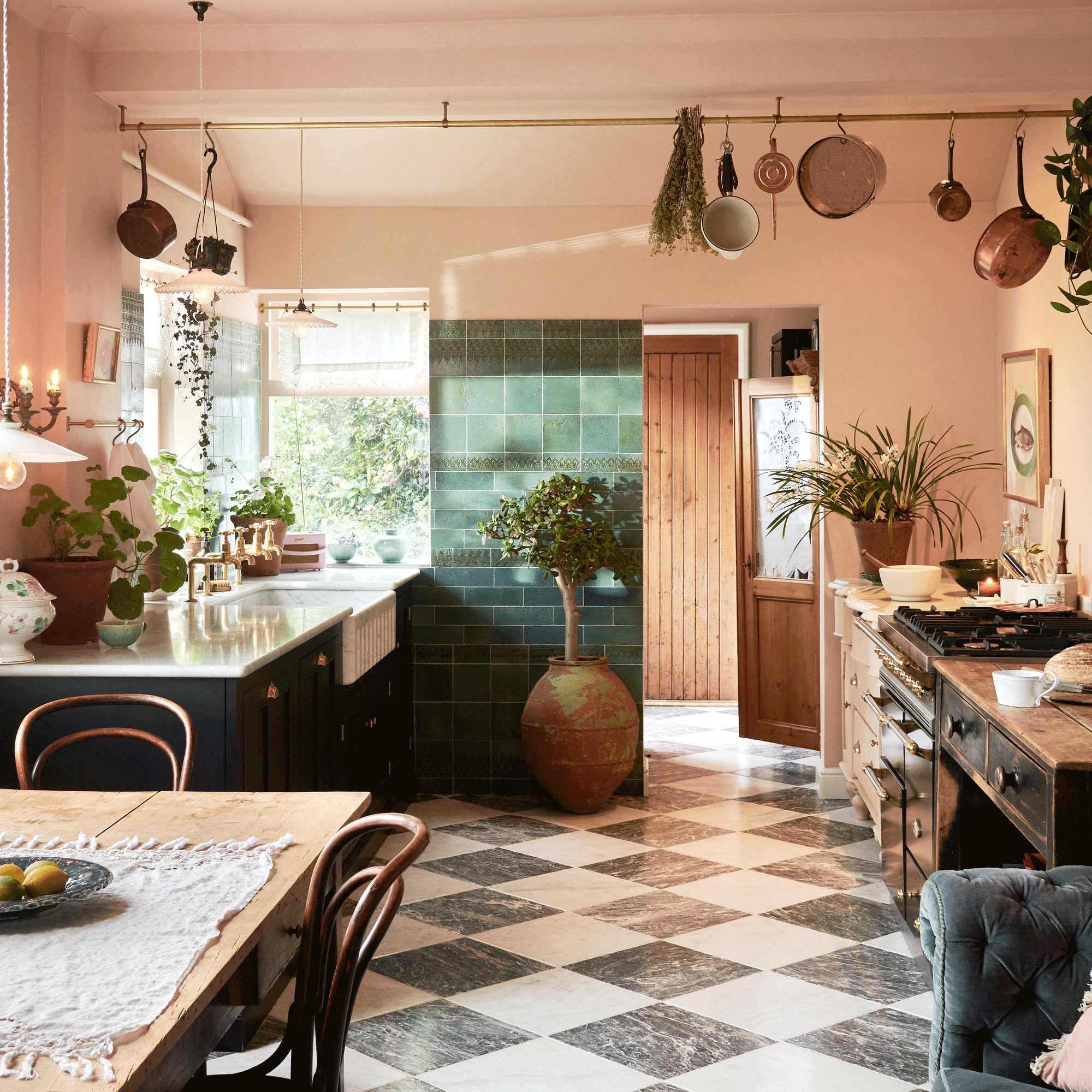
Checkerboard floors can read both traditional and modern .
(Image credit: deVOL)
“Even with a tight space, you can be as adventurous as you like as long as the floor is functional. It really does come down to personal choice and the overall look and feel of the design,” says Alex Dauley.
“Ultimately, it depends on how much of a statement you want to make with your floor. I would argue that, with small kitchen flooring, this gives you the opportunity to use pattern, color, small-format tiles and a really beautiful product, because you are only covering a compact area.”
When working with patterned kitchen floor tiles, Sarah Peake believes it’s the scale of the design that can have the most impact. “Sometimes in a smaller space, using a large pattern on the floor tile can make the room feel more spacious because the eye is tricked into thinking it can take a bigger design,” she explains.
6. Make a Bold Choice
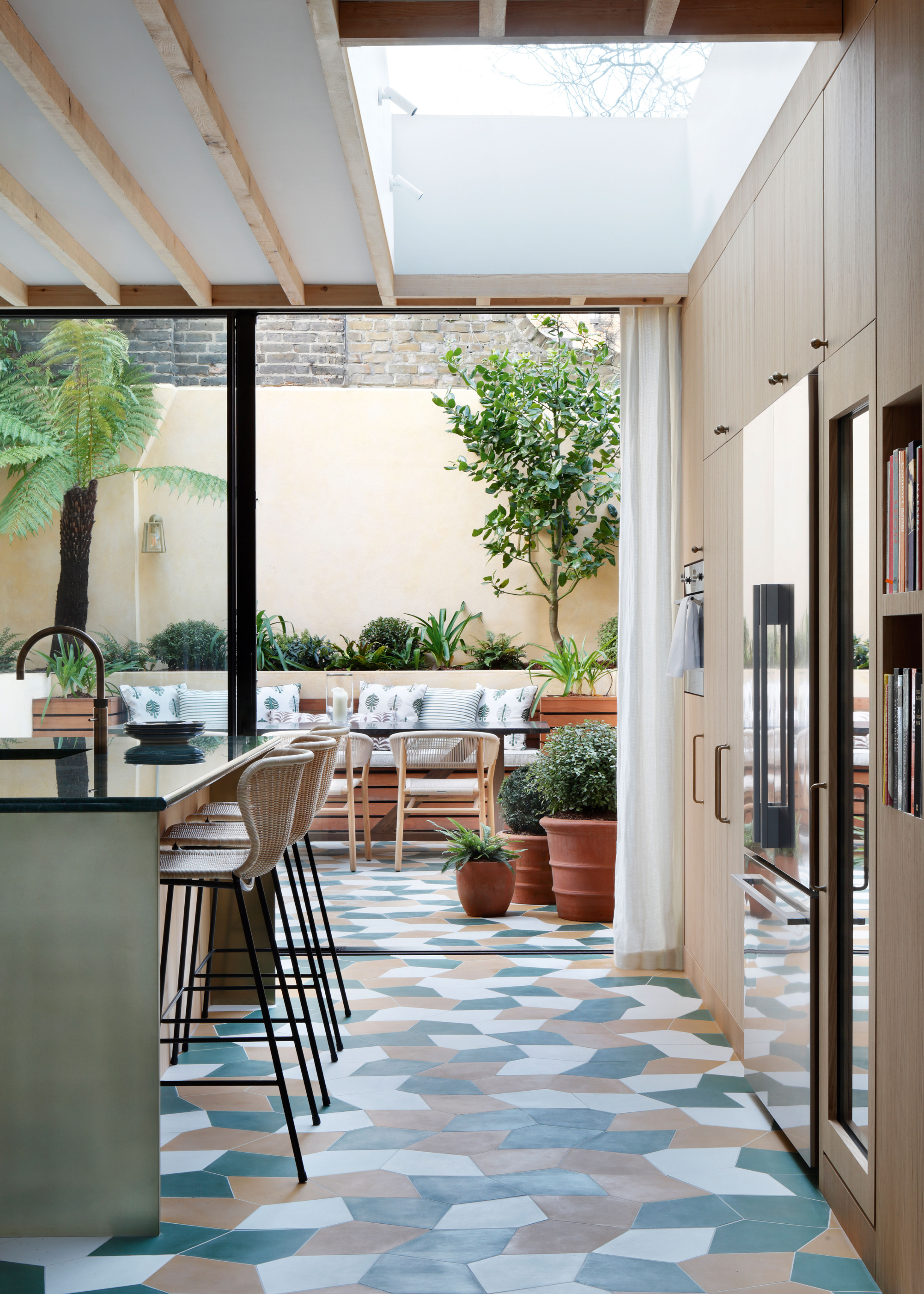
A level indoor-outdoor kitchen floor is a great accessibility feature, too.
(Image credit: Alexander James. Design: Studio Peake)
“I think a lot of people want to play it safe with flooring, understandably, because it’s not easy to change once the house is finished. Controversially, I think a bold choice can make a huge difference and, if successful, can bring personality to a room in a big way,” says Sarah Peake, who used bright tiles in irregular shapes from Mosaic Factory throughout the colorful kitchen and garden of a Chelsea townhouse project.
“It is the main entertaining space of the house and it was vital to make a strong connection with the garden. I also wanted the room to have a sense of fun. There were lots of woods elsewhere in the space, so the bold and colorful tiles cut through those more neutral tones in an exciting way and really livened up the entire floor.”
7. Get the Balance Right
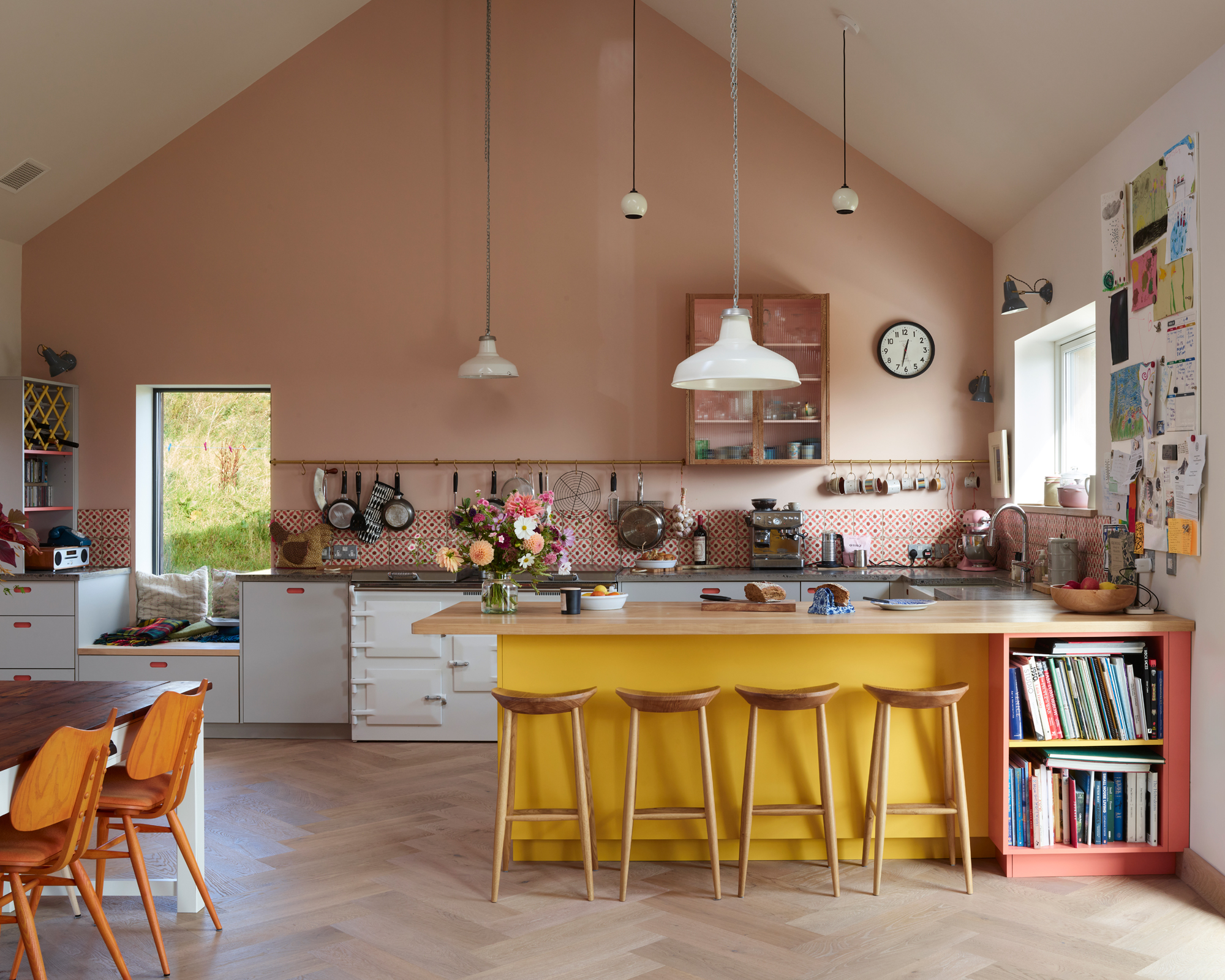
Simple flooring balances out a bolder kitchen cabinetry design .
(Image credit: Pluck)
When choosing a floor for a brightly coloured kitchen, then the safest bet is to keep it simple and neutral to avoid having too many competing elements among your kitchen color ideas.
“I recently used a yellow color called Terre Jaune by Argile on the cabinetry of a boot room in a country house project, which I combined with a limestone floor,” says Sarah Peake. “Sometimes, if I have a colorful kitchen paint color like this it can be quite grounding to combine it with a subtle floor to make the room feel less shouty.”
8. Opt for Stone Flooring
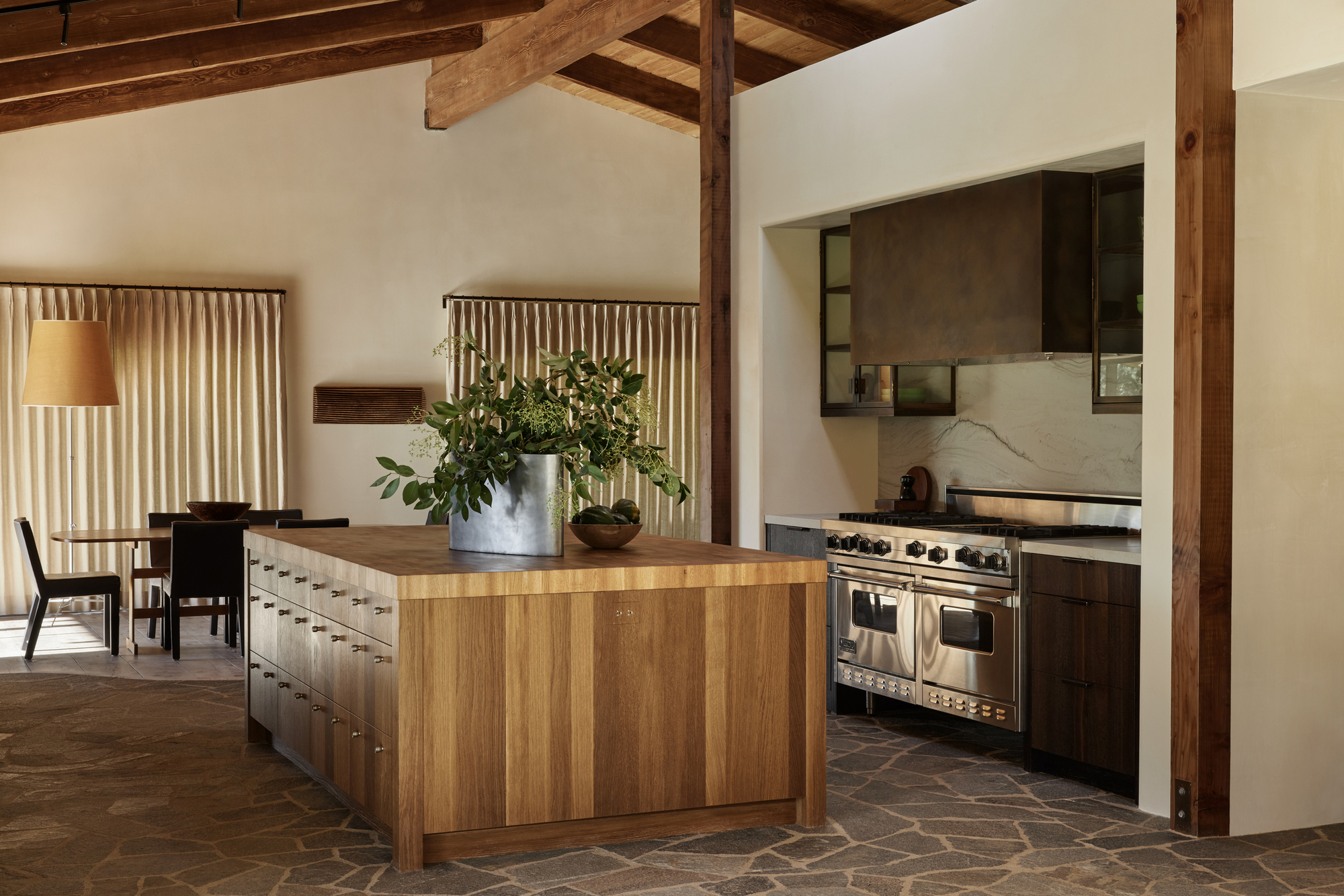
Stone flooring can take multiple forms in a kitchen, such as flagstones.
(Image credit: Nicole Franzen. Design: Corinne Mathern)
If you’re looking for an enduring and sustainable material, natural stone flooring can tick a lot of boxes, depending and how and where it’s quarried. “Natural stone has a low embodied energy and generally compares favourably to similar alternatives such as polished concrete flooring in terms of sustainability,” says Ben Ridley, who used Grassi Pietre limestone for both kitchen countertops and flooring his own low-energy home.
“If the same stone product can be used throughout a house then economies of scale on order, delivery and installation costs are also possible,” Ben adds. “Try to avoid cheap stones from non-local sources. Stone supplied from Brazil, China or India are likely to have a high embodied energy due to shipping.”
9. Try Eco-Friendly Cork
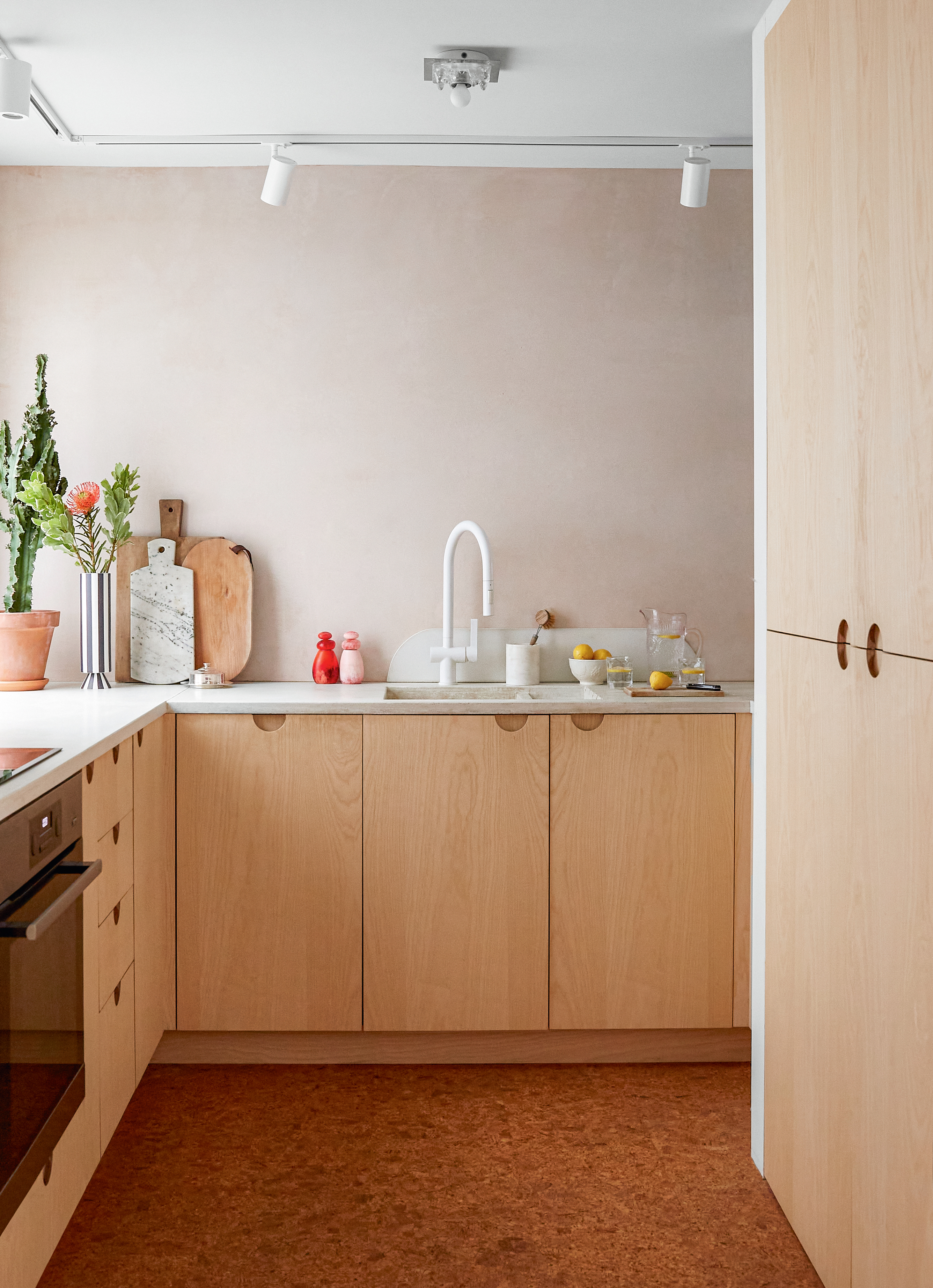
Cork gives a warmer color tone that contrasts against paler materials in this kitchen.
(Image credit: Kristy Noble)
Cork flooring seems to be the flooring at the moment. We are seeing it everywhere and the more we see it in situ the more we are drawn to its natural textures, its warmth, and its unusualness. In this kitchen, it has almost a retro feel and works perfectly with the soft, natural palette going on in here.
And as well as looking great, it’s a really practical kitchen flooring idea. Easy to clean, easy to install, easy to maintain. Syilviya Stoyanove, flooring consultant at Bricoflor says that “kitchen flooring trends have been heading towards being eco-friendly and organic and more people are rediscovering the benefits of natural materials, so it’s unsurprising cork is having a revival.”
“It’s great for sound and heat insulation, reducing energy usage and utility bills, and significantly improving the acoustics of a space. It’s also waterproof so can be installed in any room. Depending on the project it should be easy to determine what cork flooring to pick. If moisture is an issue, glue down cork tiles are best. If you seek comfort and quick installation go for floating cork tiles.”
10. Bring Patina With Reclaimed Wood
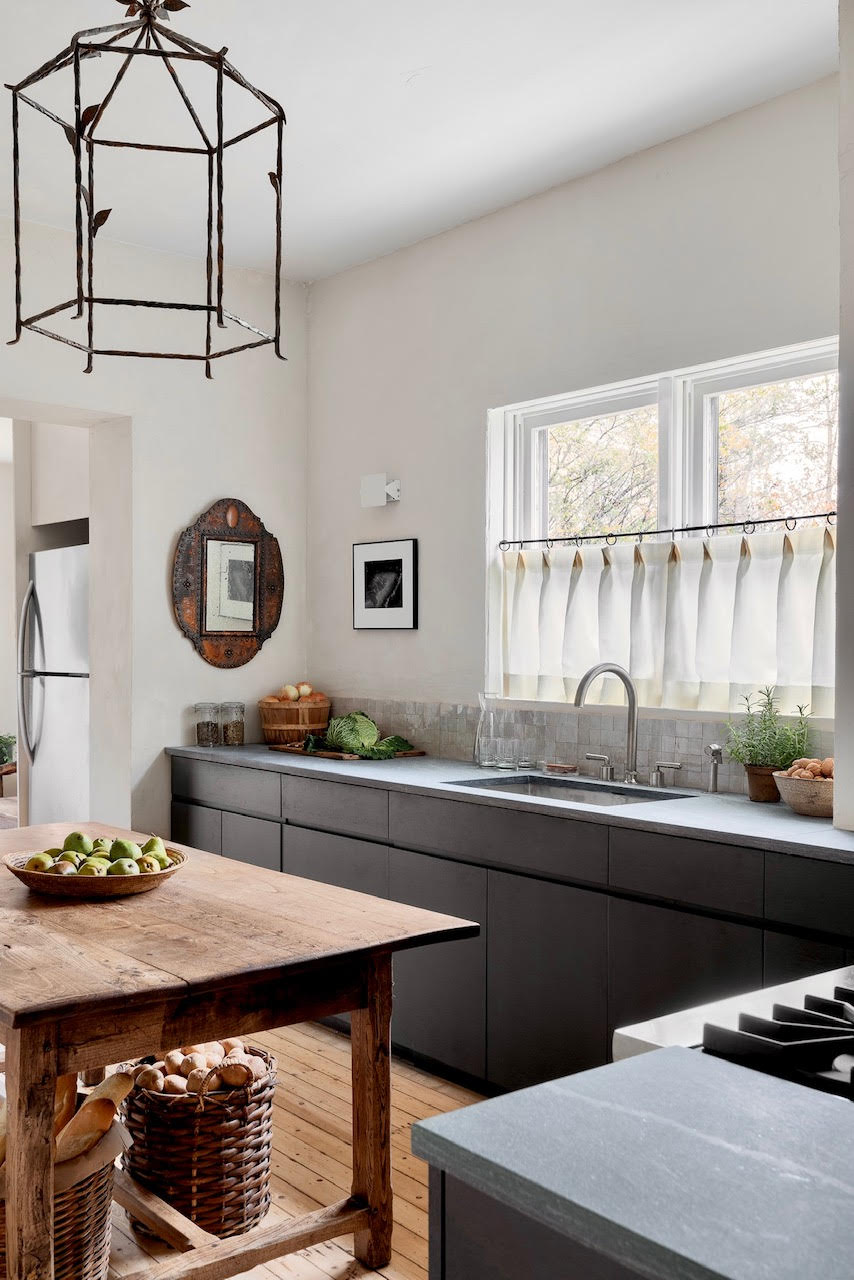
This reclaimed wood flooring brings so much character to the kitchen.
(Image credit: Ariel Camilo)
Reclaimed wooden floors are also up there with the most popular flooring types right now, as everyone seeks to create homes filled with personality and charm. As Meg Lavalette, founder of Lava Interiors explains, ‘Wood floors in kitchens are timeless. It’s always ideal to think about a house holistically too, so avoiding a material transition and especially color transition by having wood floors throughout will make for a seamless approach when having consistent wood flooring.’
You can salvage wood flooring from so many unexpected sources — school gyms, old houses, beams, lumber — and it can come in so many designs too, essentially anything you can buy new,you can create with reclaimed flooring. It’s also a great eco-flooring option as you are saving perfectly lovely wood from landfill.
11. Invest in Easy Care LVT
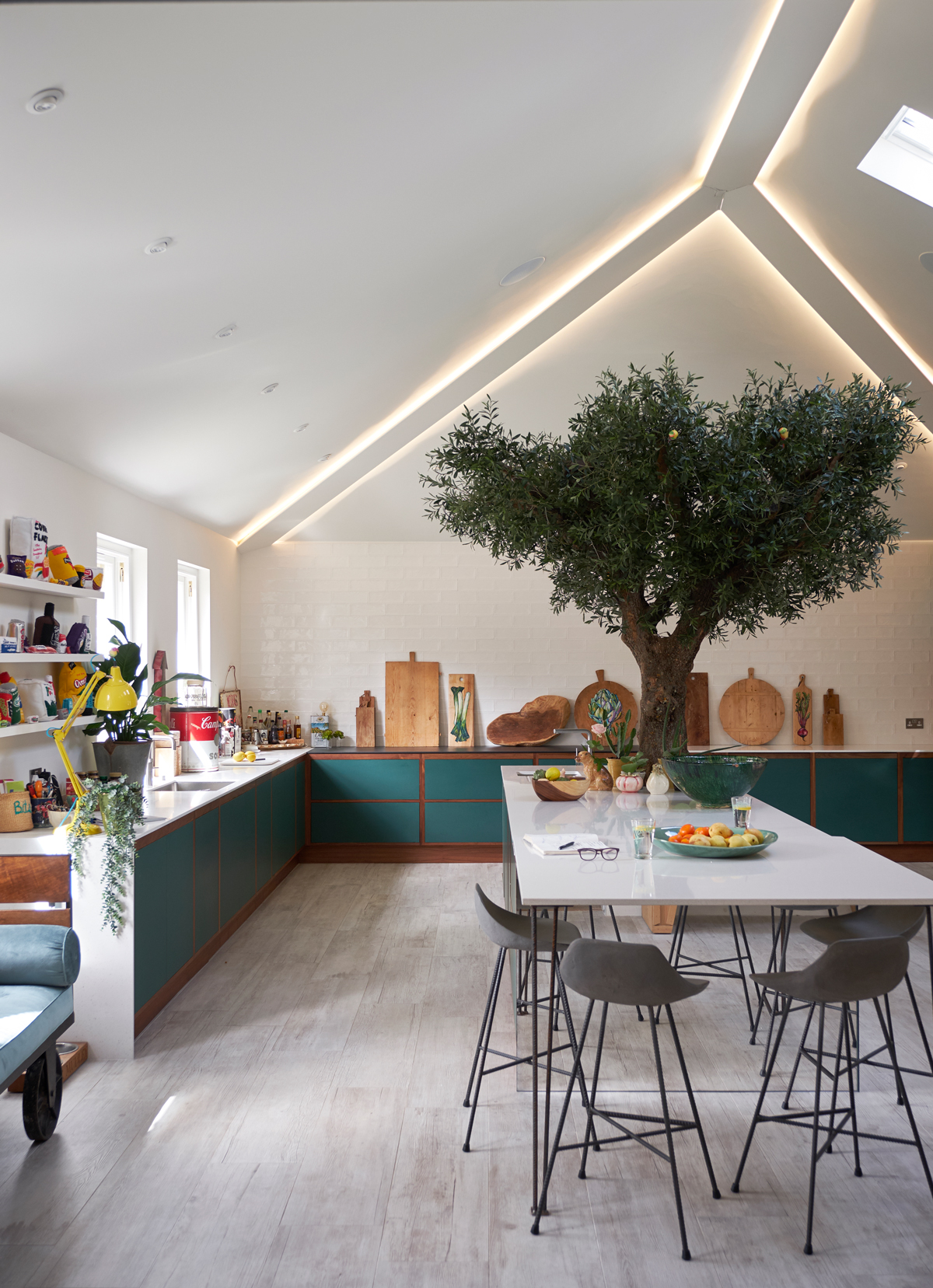
LVT is a super practical alternative to wooden kitchen flooring.
(Image credit: Sola Kitchens)
Right, before you all run away at the mention of vinyl, it’s really not what it once was. Banish any image of yellowing flooring curling at the edges and bubbling in the middle vinyl has a glow up and is a great choice for kitchen flooring, especially in the form of LVT (luxury vinyl tiles). There are so many gorgeous options out there that mimic more pricey designs from solid wood to patterned tiles.
“When buying a kitchen floor, it’s important to make an educated and informed decision. There are lots of aspects to consider before making your selection,” explains Sarah Escott, Amtico‘s Design Manager.
“The big choice is often between LVT or real wood/stone. There are advantages to both, however LVT boasts a huge number of benefits that simply cannot be replicated with its natural counterparts. One of these is maintenance. The kitchen is one of the most high-traffic areas in the home so picking a floor that requires low maintenance is key. With natural wood or stone, it can be tricky to keep it looking good as it requires regular treatment. LVT simply requires a sweep and occasional mop to keep it looking fresh.”
FAQs
What Is the Best Flooring for a Kitchen?
The best flooring for a kitchen will come down to both your personal style and how do you use your space. Tiles, wood, vinyl all have their advantages to it’s about considering how you want your kitchen floor to look and feel, how easy you want it to be to maintain, and how much you want to spend.
“Kitchen floors need to be robust and easy to clean – particularly in today’s busy homes, and with more of us having pets – so hardwearing porcelain tiles are an ideal choice,” explains Colin Roby-Welford, Fired Earth’s Creative Director. “From fantastic replica-marbles and replica-woods to colorful geometric designs, porcelain tiles are available in a host of inspiring and low-maintenance options.”
Alongside tiles, wooden kitchen floors are also very popular and the huge benefit is how timeless they look, and are the best option if you are looking to add value to your home. However, they can get pricey and aren’t the easiest to maintain as they aren’t water-resistant and can easily show scuffs and stains.
What Is the Easiest Kitchen Flooring to Maintain?
The easiest kitchen flooring to maintain would either be vinyl or ceramic tiles. Both options are usually waterproof, easy to clean, and hardwearing. They won’t need any extra maintenance like sealing or oiling and won’t easily show wear and tear.




